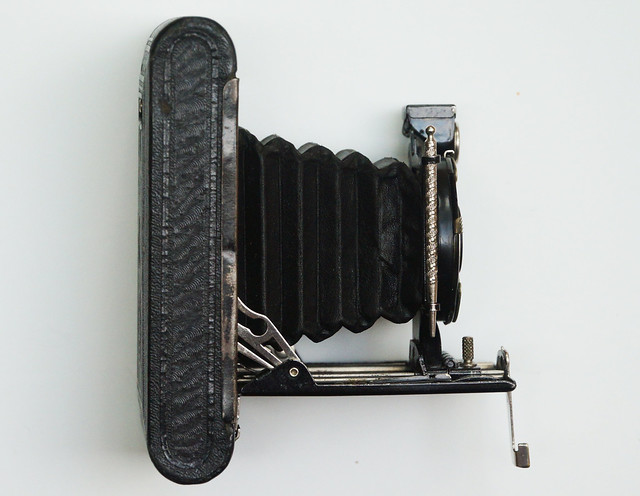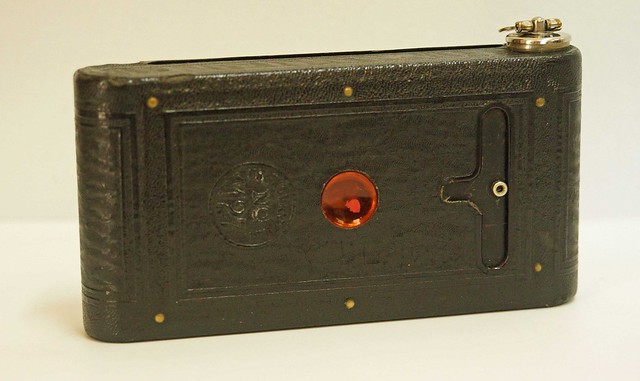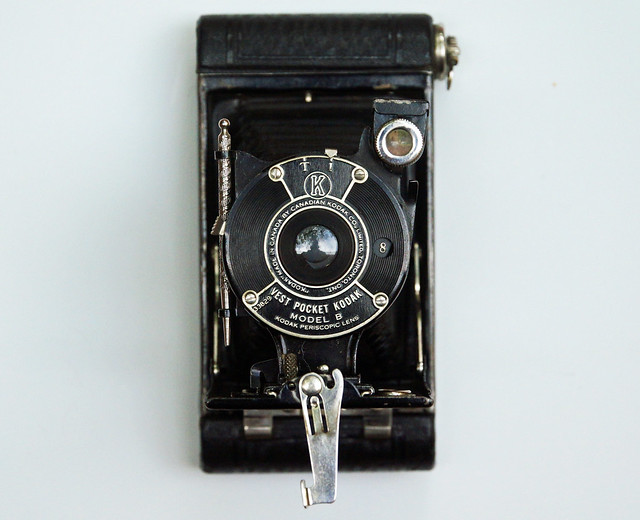I love these little Vest Pocket Kodaks. They are about the size of a Blackberry (twice as thick) folded up. Kodak made these starting in 1912, and continued until 1926. They were revolutionary at the time. As the first camera to use 127 rollfilm, about 4 centimeters long and the thickness of a magic marker, they actually fit in the vest pocket, representing an important step in the miniaturization of cameras from the cumbersome models that had prevailed until then. In 1915, another innovation came to the Vest Pocket Kodak – the autographic feature. Using special film and the metal stylus that came attached to the autographic cameras, the user could open a small window in the back of the camera, note down the date an location of the photo, and by holding it up to the light, create a kind of analog metadata file.
As a result of their portability, large numbers of these cameras were taken to the battlefields of World War I – strictly forbidden at the time – earning them the nickname “Soldier’s Camera”. In addition, George Mallory, who with his climbing partner Andrew Irvine, left their final base camp 1 km from the summit of Mount Everest a full 30 years before Edmund Hillary and Tenzing Norgay, had one of these in his possession at the time. The two didn’t survive their attempt, and Mallory’s body has been recovered, but the camera which may contain evidence that they reached the summit before Hillary is still missing.
The little appendage on the top right of the lens, above, is the finder. The camera is held at waist level, and you look straight down into the finder, which allows you to see where the camera is pointing. This also helps keep the camera stable.
The camera has two settings – “T” and “I”. The “T” setting basically allows you to leave the shutter open as long as you want – you click the little shutter switch to open the shutter, then again to close it. The “I” button opens and closes the shutter quickly. No idea what the shutter speed is – typically the cameras of this time run around 1/40th to 1/60th of a second. The aperture is set with a dial that moves different openings across the front of the shutter – from f/8 all the way to f/64. Using small apertures likely made it possible for most pictures to be in focus – but it’s probably also why you’d need to leave the shutter open for seconds at a time!
So I decided to take this camera for a “spin” last weekend to see how it performed. And to sum up, I was a bit disappointed.
- This is a guy reading the paper outside. Can you tell?
- A young man sits with the usually-ignored “beach dogs”
- Obscured by light, a fellow photog snaps a photo of a child
- Giant chess pieces by the beach.
- Fellow photog chats with a bearded man
- “Laughter Therapy” Group
As is the case in many cameras this old, about half the photos show light streaks, which are evidence of a leak. The bellows in these cameras typically become worn and cracked over time, and tiny pinholes develop in the corners. I had checked this, but after I saw the results of these photos I checked again. This is done by going into a pitch black room and putting a bright flashlight into the camera bellows. Turning the camera in all directions, I finally spotted about 4 miniscule holes. These will need to be repaired before I’ll try this again! This can be done in many cases with a mixture of white glue, a bit of dishwashing soap, and black liquid dye or shoe polish.
For more posts about this innovative camera (100 years ago, anyway!), you can check out the following links:
Cameras Classicas blog post
Japan Camera Hunter
KodaksEfke
Article about the Everest Mystery











